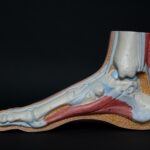In the world of sports medicine, few topics are as critical and fascinating as the distinctions between tendons and ligaments. These two crucial components of our musculoskeletal system play distinct roles in the stability and movement of our bodies. Understanding the key differences between tendons and ligaments is not only essential for athletes and fitness enthusiasts but also for anyone seeking to grasp the intricacies of human physiology. In this article, we will dive into the captivating world of tendons versus ligaments, exploring their functions, structures, and the remarkable ways in which they heal. So, whether you’re an aspiring athlete, a curious reader, or someone looking to expand their knowledge, get ready to unravel the mysteries of tendon versus ligament.

Tendon vs Ligament
In the world of anatomy and orthopedics, tendons and ligaments are two important components that help support the body’s structure and movement. While they may seem similar, there are key differences between tendons and ligaments that play distinct roles in our bodies. In this article, we will explore the contrasting functions, structures, and healing processes of tendons and ligaments, shedding light on their unique roles in maintaining our musculoskeletal health. So, let’s dive in and unravel the mysteries of tendons and ligaments!
Tendons and ligaments are both types of strong and dense connective tissues, but their functions and locations within the body set them apart. Tendons are thick bands of tissue that connect muscles to bones. Imagine tendons as strong ropes that transmit the force generated by contracting muscles to the bones, allowing us to move our bodies with precision and control. Without tendons, our muscles would have no means of connecting to the bones, rendering us immobile.
In contrast, ligaments connect bones to other bones, serving as stabilizers for our joints. Picture ligaments as flexible bands that hold bones together, providing support and stability during movement. Without ligaments, our joints would lack the necessary reinforcement and become unstable. This is especially crucial in sports, where ligaments protect our joints from injuries during rigorous activities.
Now that we understand the basic difference between tendons and ligaments, let’s delve deeper into their structures and characteristics. Both tendons and ligaments are fibrous connective tissues primarily composed of collagen, a protein that gives them their strength and resilience. However, there are some notable differences in their composition.
Tendons consist predominantly of parallel collagen fibers, arranged in a highly organized manner. This alignment ensures their ability to withstand tension and transmit the force from muscles to bones effectively. Tendons are incredibly strong and durable, yet they also require a sufficient blood supply to receive essential nutrients and oxygen for proper function and repair.
On the other hand, ligaments contain more elastic fibers than tendons, giving them greater flexibility. This elasticity enables ligaments to allow a wider range of movement in our joints. However, it’s important to note that this increased flexibility comes at the cost of reduced overall strength compared to tendons.
When it comes to injury and healing, both tendons and ligaments are susceptible to tears, commonly referred to as strains and sprains, respectively. These injuries can occur due to trauma, such as sudden twisting or stretching beyond their capacity. Tears can range from partial to full, with the severity determining the healing process and timeline.
It’s fascinating to know that tendons and ligaments have low vascularity and cellularity, meaning they have a limited blood supply and contain relatively fewer cells. The primary cell type found in both tendons and ligaments is the fibroblast, responsible for producing and maintaining the collagen fibers that give these tissues their strength. Additionally, research has discovered the presence of stem cells within tendons and ligaments, which may play a role in the repair and regeneration of these tissues.
In summary, tendons and ligaments are essential components of our musculoskeletal system, each with its unique function and structure. Tendons connect muscles to bones, enabling movement by transmitting forces, while ligaments stabilize joints by connecting bones to other bones. Tendons are sturdy and arranged in an organized manner, while ligaments possess more elasticity to allow flexibility in our joints.
Understanding the distinctions between tendons and ligaments is crucial for athletes and individuals seeking to maintain their musculoskeletal health. By knowing how these tissues function and interact, we can better prevent injuries and make informed decisions when it comes to rehabilitation and treatment. So, the next time you engage in physical activity or experience joint discomfort, remember the vital roles tendons and ligaments play in keeping our bodies strong and mobile.
Tendons and ligaments are often used interchangeably in everyday language, but did you know there’s actually a significant difference between the two? If you’re curious to understand the disparities, click here to explore the dissimilarities between tendons and ligaments. You’ll find all the information you need at ../difference-between-tendon-and-ligament.
FAQ
Question 1
What is the main difference between tendons and ligaments?
Answer 1
The main difference between tendons and ligaments is that tendons connect muscles to bones, while ligaments connect bones to other bones.
Question 2
What are the functions of tendons and ligaments?
Answer 2
Tendons transmit force from contracting muscles to bones to move the body, while ligaments maintain the stability of joints.
Question 3
Where are tendons and ligaments located in the body?
Answer 3
Tendons are fibrous connective tissues that connect muscle to bone, while ligaments are fibrous connective tissues that connect bone to bone. Tendons are located throughout the body, connecting muscles to bones, while ligaments are located at joints, connecting bones to other bones.
Question 4
What happens if tendons or ligaments tear?
Answer 4
Both tendons and ligaments can tear with significant trauma, and tears can be partial or full. In the case of a tear, medical intervention may be required for proper healing and rehabilitation.
Question 5
Do tendons and ligaments have any regenerative capabilities?
Answer 5
Stem cells have been found within tendons and ligaments, and they may play a role in repair and regeneration. However, the extent of their regenerative capabilities is still being studied.
- Senior at What Age: Benefits & Eligibility Guide - March 29, 2025
- Unlocking Senior Benefits: How Old is a Senior? Your Complete Guide - March 29, 2025
- Master Russian Politeness:A Guide to Saying Please - March 29, 2025
















